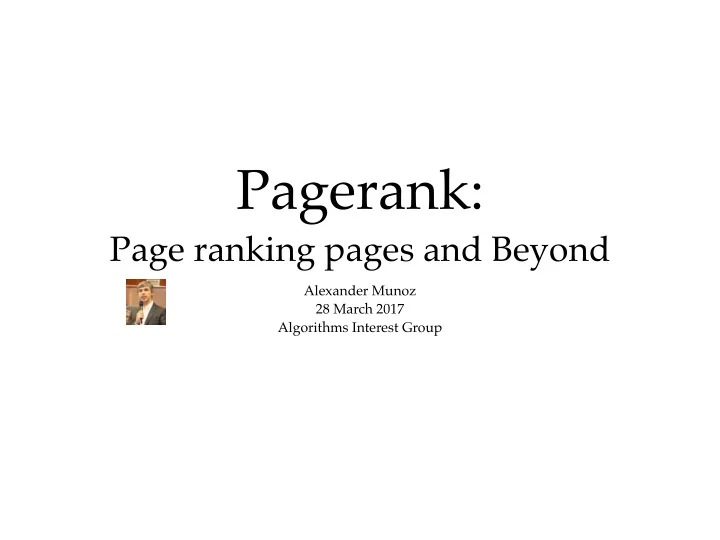

Pagerank: Page ranking pages and Beyond Alexander Munoz 28 March 2017 Algorithms Interest Group
Outline • High-level description • Low-level Description • Examples • Google’s Synthesis • Applications
High-Level • Pagerank solves a system of “score” equations • Yields a probability distribution that a person randomly clicking links will arrive at a particular page
High-Level • Google interprets a link from page A to page B as a vote by page A for page B • However, not all votes are equal • The rank (importance) of a webpage gets factored in — high ranked votes weigh more heavily
Random-Surfer Model • Probability that a random surfer clicks on a link is given by the number of links on a page • The probability of reaching a page is the sum of probabilities for the surfer followings links to the page • Introduce a damping factor which gives a chance to jump to another page at random — minimum Pagerank
Lower-Level • Within a network, we can calculate the Pagerank of a particular page • Say page A has pages T 1 …T n pointing to it and we have links going out of page A classified as C(A): " # PR ( T 1 ) C ( T 1 ) + · · · + PR ( T n ) PR ( A ) = (1 − d ) + d C ( T n )
Lower-Level • PR can be calculated using a simple iterative algorithm • PR corresponds to the principal eigenvector of the normalized link matrix — we can calculate PR without knowing the final PR values of other pages • Computation can be done iteratively or algebraically — Power method
Lower-Level PR ( p i , 0) = 1 • Iterative: N PR ( p i , t + 1) = 1 − d PR ( p j , t ) X + d L ( p j ) N p j ∈ M ( p i ) R ( t + 1) = d M R ( t ) + 1 − d 1 N 1 where M = L ( p j ) Converges when: | R ( t + 1) − R ( t ) | < ✏
Lower-Level • Algebraically: as t goes to infinity R = d M R + 1 − d ˆ 1 N The solution is given by R = ( I − d M ) − 1 1 − d ˆ 1 N
Lower-Level • The previous calculations yield the same Pageranks if their results are normalized: R power = R iter | R iter | = R alg | R alg |
Lower-Level • Quick demonstration PR(A)=0.5+0.5*PR(C) PR(B) = 0.5+0.5*(PR(A)/2) PR(C) = 0.5+0.5(PR(A)/2+PR(B)) • Iteration PR(A) PR(B) PR(C) • 0 1 1 1 • 1 1 0.75 1.125 • 2 1.0625 0.765625 1.1484375 • 3 1.07421875 0.76855469 1.15283203 • 4 1.07641602 0.76910400 1.15365601 • 5 1.07682800 0.76920700 1.15381050 • 6 1.07690525 0.76922631 1.15383947 • 7 1.07691973 0.76922993 1.15384490 • 8 1.07692245 0.76923061 1.15384592 • 9 1.07692296 0.76923074 1.15384611 • 10 1.07692305 0.76923076 1.15384615 • 11 1.07692307 0.76923077 1.15384615 • 12 1.07692308 0.76923077 1.15384615
Improving your Pagerank • Add new pages to your website — in a semi- intelligent way • Swap links with websites which have high Pageranks • Raise the number of inbound links (Advertising)
Improving your Pagerank • When you add a new page to your site, link it to the front page • You can reduce your front page’s Pagerank by making circular references in your website
Improving your Pagerank
Improving your Pagerank These manipulations are not enough — create good content instead
Google’s Synthesis • Ranking of webpages in Google was determined by three factors -Page specific factors -Anchor text of inbound links -Pagerank • Measuring an inbound link’s potential for pointing the correct information “Calculating derivatives in three dimensions ” vs. “ Calculating derivatives in three dimensions”
Google’s Synthesis • Specific factor examples -Domain registration length -Penalize WhoIs Owner — spammers get punished -Keyword in title tag -Keyword density -Page loading speed via HTML -Outbound link theme -Reading level • Many, many more factors: social signals, domain factors, page factors, algorithm rules, backlink factors…
Google’s Synthesis • In order to provide search results, Google computes an IR score from the first two components • Pagerank multiplied with the IR score yields the general importance of the page
Google’s Synthesis
Applications • Ecology — Food Webs • Uses cyclical elements — Animal to detritus to plants to Animal • How does the loss of a species cascade? Measure the importance of the species
Applications • Recommendation Systems — e.g. Netflix • User identifies what they like • A movie is relevant for me if other similar people liked it and A person is similar to me if they like movies that are relevant to me • Whenever user u likes product m, we draw two edges, one from node u to m and the other one from node m to u
Applications • League of Legends Balance Analysis
Applications • League of Legends Balance Analysis
Conclusion • Pagerank is a simple algorithm which gives rise to a fair amount of complexity • Pagerank-type algorithms have developed to build descriptions of a wide range of phenomena
Bibliography • https://en.wikipedia.org/wiki/PageRank • Examples and Principles: http://www.cs.princeton.edu/ ~chazelle/courses/BIB/pagerank.htm • Larry Page: http://ilpubs.stanford.edu: 8090/422/1/1999-66.pdf • Google specifics: https://prchecker.net/how-pagerank-is- used-in-google-search-engine-application.html • Application: http://journals.plos.org/ploscompbiol/article? id=10.1371/journal.pcbi.1000494
Recommend
More recommend